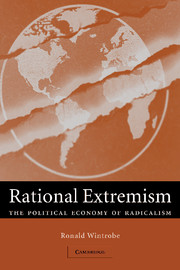7 - Rational Revolutions
Published online by Cambridge University Press: 31 July 2009
Summary
Introduction
Historically, suicide martyrdom has not been the most important manifestation of extremist activity. This part considers a number of other manifestations of extremism: revolution, nationalism, dictatorship, and global jihad. This chapter looks at revolutionary activity, a specter that haunted Europe after the great French Revolution of 1789 and frightened the world after the Russian Revolution.
One thing suicide martyrdom and revolution have in common is that they are both difficult to explain with standard rational choice theory. Thus, it is commonplace in the modern analysis of revolutions to say that rational choice can't explain them. The rational choice approach is identified with the line of thought initiated by Olson (1965) and applied to revolutions in detail by Tullock (1971). They focused on the free-rider problem. Because the benefits of the revolution are a public good, available to every individual whether he participates in revolutionary activity or not, and because the contribution of any one individual to making the revolution happen is usually trivial in any society of reasonable size, no rational person will decide to participate. Hence revolutions cannot occur unless some private benefit, which Olson termed “selective incentives,” can be found to motivate participation. In turn, because it is hard to imagine how these could be provided at the mass level, revolutions do not occur.
However, revolutions do occur now and then, and this poses a problem for the theory.
- Type
- Chapter
- Information
- Rational ExtremismThe Political Economy of Radicalism, pp. 161 - 189Publisher: Cambridge University PressPrint publication year: 2006

